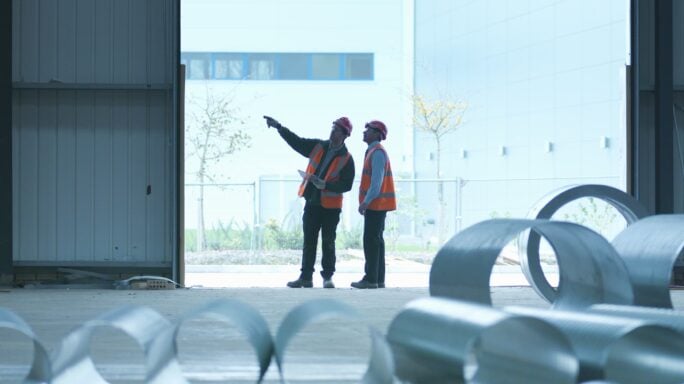Construction
How construction firms can mobilize digital data and reduce manual paperwork
Discover how moving away from paper processes and towards a digital approach can help your construction firm save time and money spent managing admin.

The construction sector is known to work on wafer-thin margins. Yet, according to McKinsey, construction is one of the least digitized industries in adopting digital technologies that could deliver time and cost savings.
But with the advent of paperless tech now moving at the speed of light, firms will have to accelerate work to digitalize and phase out manual sharing of paper documents.
‘Going digital’ isn’t easy. But, done right, it brings opportunities to implement systems that support high standards, mobile working, time and cost savings, as well as business growth.
It will also help you to ensure that mobile workers and subcontractors adhere to the same standards. This can be easily achieved when third parties use mobile apps to record and manage business information relevant to your business.
Read this article to find out how to mobilize digital data, so you can help your business get ahead.
Challenges of using manual paperwork processes
Construction firms have embraced the use of new technologies such as Building Information Modelling (BIM) on behalf of clients but have been slower to adopt digital technologies within their own businesses.
James Howard is the managing director of Sherwood Systems, which tailors business management systems on behalf of clients in the construction sector.
He says around 40% to 50% of construction firms’ processes are still paper-based.
That means firms can easily become victims of their own success – when winning new contracts can easily quadruple the amount of administration they have to manage, within a matter of weeks.
With ever-increasing requirements for robust data on compliance, and health and safety, this reliance on paper also presents several potential risks that will waste your time, effort and money.
These include the following:
Reduced visibility and control
Without digital data, many construction firms don’t identify issues until year-end. This reactive approach means there are fewer actions they can take to address potential problems.
In addition, fewer back office staff are now working on sites, so no longer have access to key documents when they need them.
Reduced productivity and control of mobile teams
In this time of a new normal, it’s almost impossible to keep track of a disparate workforce without a proper system.
Risk of loss
Using paper puts your business records at risk from black swan events such as fire, flooding, and theft.
Mistakes, duplication and inefficiency
Paper-based systems often have fewer controls. It’s all too easy to send the wrong document or lose control of versions, which leads to time being wasted.
Increased administration and cost
Without caution, your staff end up spending time manually processing data instead of supporting business growth.
According to Howard, it costs between $5 and $25 to process just one purchase order – a cost that can rack up very quickly when you order thousands of items.
Reduced accountability
When using manual processes, it’s harder to keep a robust paper trail confirming actions, whether processes have been followed, and who signed off on key decisions.
Restricted growth
You can’t increase productivity or profit without having a decent system in place. With low margins, you can’t afford not to automate routine transactions.
Why using digital data is more efficient
Despite the challenges, 81% of construction firms said they planned to improve their businesses digitally in 2020, according to research from Causeway, which seeks to optimize performance in construction.
Benefits of doing so include:
Increased visibility and control, including the mobile workforce
With access to real-time data, you can get a full understanding of performance at any time, and use data to make informed and proactive decisions.
By involving suppliers and subcontractors, you can split the burden of administration and ensure everyone takes responsibility for their actions.
Better productivity
Construction firms that have digitalized their processes said new management technologies increased productivity by 15%, according to Causeway.
Around 88% of construction firms said that if implemented, digitalization would increase employee productivity.
Improved security
With a secure online system, you can reassure clients and external stakeholders that your systems are well-protected against black swan events, with data accessible 24/7 and a reduced risk of transmission of coronavirus.
Reduced cost
Digital systems can reduce costs by around 20%, which could spell the difference between financial success and failure in construction, an industry that has tight margins.
Improved accountability
Having a clear digital paper trail, covering all aspects of your business and projects, offers you maximum reassurance and protection in the event of any incident or accident.
Improved accuracy and efficiency
You can avoid wasting time by ‘designing out’ potential mistakes.
Automate key aspects of processing transactions
This can include the likes of scanning and recognition of barcodes on delivery dockets to ensure transactions are married up appropriately in the system.
By creating rules, you can stop any transaction being authorized without the correct process being followed.
By streamlining routine transactions such as purchase orders, your system will quickly pay for itself.
Create a flexible workforce to support growth
By shifting to a digital system, you can maximize the flexibility of your workforce.
For example, you can fulfill increases in work without having to recruit new people. In addition, you can free up your people to work on value-add activity such as bidding and developing brand proposition, instead of administration.
Areas you can streamline using mobile and electronic data
Digitalization enables you to get the right information to the right people at the right time. It can result in you making efficiencies across the entire business, covering:
- Estimating: Use online tools instead of sharing paper spreadsheets to increase inefficiency.
- Financial documents: Streamline processes through the whole lifecycle – from requisitions to payment received – using tools such as barcode scanners, uploaded photos of delivery dockets and automation technology married together in a single system. And you can consolidate multiple documents into a scanned invoice to save time.
- Work in Progress (WIP) inquiries/reports: Quickly summarize sophisticated data into simple reports.
- Budget control: Get an instant understanding of budgets and costs for sites, projects, or phases whenever you need it.
- Processes: Speed up processing by implementing clear procedures and rules for all workers, including mobile staff. Delegate administration to known individuals. Control approvals and sign offs.
- HR: Manage holidays, training records, certificates, disciplinary procedures with ease.
- Health, safety, environment, quality: Keep robust and reliable records relating to certifications, accreditations, site issues, and near-misses.
- Financial reports: Provide key data and insight for the management team with a few clicks.
Seven steps to mobilize digital data
Digital transformation marks a major shift for medium-size construction companies. It’s sensible to adopt a realistic and phased approach.
Here are seven steps for your firm to take in order to mobilize digital data.
1. Set up a project team
Get representation from all departments and functions likely to be impacted by a shift to digital. This will maximize expertise and engagement.
2. Get feedback
Encourage people to make suggestions, to maximize engagement and support.
3. Review the data you have
Do you actually need to collect all of this information? Does this data need to be inputted into a new system, or can it be removed completely?
Take the time to review what you have.
4. Map processes
Review whether your processes cover all workers, including mobile teams. Scope what you are trying to achieve and, if necessary, create new processes aligned to these objectives.
Streamline stages wherever you can.
5. Draw a line under selected paper processes
Communicate with your teams any deadlines when paper processes will end and new systems will start, so everyone is prepared.
6. Work in phases
Don’t try to change everything at once or you risk being overwhelmed and replacing one form of administration with another.
Start by digitalizing one or two processes and build the system over time.
7. Ask for help
Don’t be afraid to ask for support from a specialist to tailor solutions to meet your needs.
Final thoughts
There’s no doubt that digitalizing your business can be a challenge.
But if your construction firm can rise to it and tackle it head on, you’ll be rewarded with reduced time, effort and cost associated with manual processes, resulting in a renewed focus on growth.







Ask the author a question or share your advice